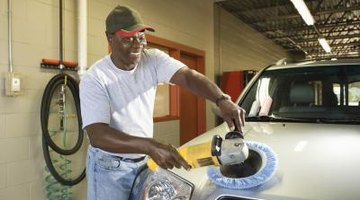Wool Vs. Foam Polishing Pads
Wool and foam pads are the “king” materials of auto detailing. If you are cleaning, polishing or using a compound, you will achieve the best results with a wool or foam pad versus using cloth rags and towels. Both types are used by the pros and most often in combination with a circular polisher or high-speed buffer appliance. However, even if you are hand detailing a car without a device, you can still use wool and foam pads to achieve better results.
Wool

Wool pads are categorized as “cutting” pads, in that the fibers of the wool “cut” into the paint to produce and restore shine and luster when detailing and buffing a vehicle. There are three main types of wood pads: four-ply, blended and finishing wool pads. Four-ply wool pad is considered an “aggressive” pad, in that it cuts harder. As a result, they are not recommended for new, clear coat auto finishes. Blended wool pads contain natural and synthetic fibers, so they are not as aggressive and can be safely used on new coat finishes. Finishing wool pads are made of 100 percent natural fibers, such as lamb’s wool. This type of pad stays soft while used for buffing because it contains natural oils, such as lanolin, which keep the pad soft and less aggressive. They are safe to use on all types of vehicles and reduce the occurrence of tiny scratches that a wool pad might leave behind after buffing.
Foam
For cleaning, light compounding and for final polishing and buffing, foam pads are a good choice. They are far less aggressive than wool pads, but they produce more heat when in use. This makes them a good choice for targeted finishing and buffing to remove minor scratches from the paint surface. There are two general types of foam pads: open-cell and closed-cell. Open-cell foam pads have holes, similar to sponges, while closed-cell foam pads have an even surface. Closed-cell pads are less aggressive than open-cell pads, and a better choice for final buffing and finishing.
Similarities
You can alternative between wool and foam pads for different tasks. For example, you can start with a wool pad to remove wax applications and finish with a foam pad to clear residual polish and wax and eliminate streaks and scratches. Both types of pads are circular in shape and have loops on the back for attaching the pads to circular, high-speed polishing and buffing equipment. Pads range in size from 6 to 10 inches in diameter. All types of pads should be cleaned immediately after use with a detergent specifically made for cleaning polishing pads. This will prevent polish and wax from caking and hardening on the pad, and ruining the pads. Never use a dirty pad on a freshly cleaned car, as the old polish will moisten and streak the car finish when it makes contact with the new polish. As a result, detailing will take longer and become a more tedious process.
Differences
Wool pads are a more common choice for cleaning because of their cutting ability to lift and remove dirt and grime. With the exception of lamb’s wool, foam pads are a safer choice for final finishing and detailing because they are not as prone to produce scratches. It’s also better to use a smaller diameter foam pad for finishing, such as a 7 ½-inch pad, to reduce swirl marks when using the pad with a high-speed bugger. Wool pads do not have such a problem because they do not generate as much heat and therefore are less likely to create swirl marks.
References
Writer Bio
Cheryl Munson has been writing since 1990, with experience as a writer and creative director in the advertising industry. She holds a Bachelor of Arts in journalism with a focus on advertising from the University of Wisconsin in Madison.
Photo Credits
- Jupiterimages/Comstock/Getty Images
More Articles



